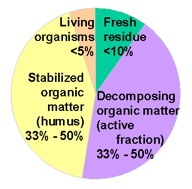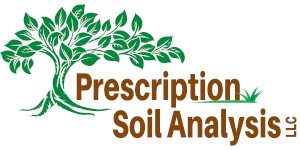Healthy soil requires organic matter, which is critical for so many reasons. Organic Matter (OM) should comprise a minimum of 5% of the soil’s volume and, as the graphic shows, is broken into several different types. 10% to 15% is preferred. Ideally, the amount of organic matter should be divided into the categories in the graphic to the right. Creating OM is a dynamic process that includes living organisms, fresh residue (sometimes green like grass clippings), decomposing, and stabilized (fully decomposed) organic matter.
Some benefits:

- Reduces soil compaction
- Fertility is enhanced
- Reduces nutrient leaching
- Soil erosion may be reduced
- Organic matter increases biological activity
- Greenhouse gases can be reduced due to Carbon Sequestration in the soil
- Organic Matter can hold up to 10 times its weight in water
- Healthy soil, with a good amount of OM, is the color of a 70% chocolate candy bar
Perhaps most important, organic matter is required to sustain biological life in the soil.
The greater the amount of OM, the greater the potential for dynamic biological activity.
We should not overlook the important benefits of carbon sequestration either. Organic matter is defined by its carbon content. High amounts of organic matter in the soil will absorb carbon dioxide from the atmosphere. If one-third of all residential property in the United States had soil with at least 5% organic matter, it would be equivalent to taking 1 million cars off the highway. Couple this with planting millions of trees, and concerns about excessive atmospheric carbon dioxide would disappear.
